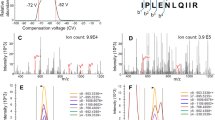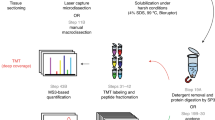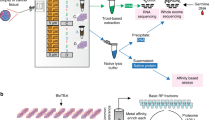Abstract
Proteomic profiles of tumor protein expression by the surface enhanced laser desorption-ionization time of flight (SELDI-TOF) methodology have been shown to have a potential usefulness for protein discovery as well as screening, diagnosis, prognosis and therapeutic considerations of cancer from several organ systems. Fine-needle aspiration (FNA) specimens from tumor samples is an accepted method to diagnose the cells of interest but often can be a limited assessment due to quantity of the sample. The current use of fresh or rapidly frozen specimens for proteomic profiling can be burdensome for clinicians to collect and submit specimens. The current study tests the hypothesis that placement of FNA and other cytological material in PreservCyt® may be an acceptable method of sample handling for protein profiling evaluation by this method though it may not be suitable for true protein discovery or characterization. Excised fresh breast tissue for evaluation and/or treatment of a variety of breast lesions were sampled by FNA technique and placed into PreservCyt®. These samples were then homogenized under denaturing conditions and evaluated by the SELDI-TOF methodology. Most samples collected showed a satisfactory quantity of protein for analysis by the SELDI-TOF methodology. Protein patterns from a variety of benign and malignant lesions revealed reproducible patterns on triplicate testing. Benign lesions had similar protein patterns across age groups in this limited series that may have potential diagnostic significance. In conclusion, FNA of breast tissue placed in PreservCyt® is a potentially acceptable method of sample handling for evaluation by the SELDI-TOF methodology for establishment of reproducible protein patterns. Preliminary results from a spectrum of breast lesions suggest these patterns may have potential for ancillary testing for diagnostic consideration of breast lesions. This collection methodology could simplify sample gathering for further testing of all types of cytological specimens by the SELDI-TOF methodology. Larger studies will be needed to assess this methodology as a diagnostic aid.
Similar content being viewed by others
Main
Fine-needle aspiration (FNA) is a well-accepted method of obtaining cells for the diagnosis of tumors for routine cytological evaluation.1 However, clinician performed aspirates, those aspirates without immediate interpretation, or without collection by special methodology may fall short of being diagnostic. This may be due to nondefinitive cytological features or due to insufficient sampling for applying currently accepted ancillary testing such as immunohistochemical staining or immunocytochemical staining with proper controls. Current ancillary testing also does not appear conclusive for invasive vs in situ lesions of the breast2 thus resulting in a nationwide decline in utilization of aspiration as a diagnostic technique for breast cancer diagnosis and current clinician therapeutic decision making (ie, sentinel node biopsy). This has resulted in a more costly and invasive approach by image-guided core sampling for all lesions of the breast even when breast lesions are palpable. Thus, a search for a better ancillary testing method to accompany the cytological appraisal of the FNA that can become timely, cost efficient, as well as comparing diagnostically favorable or surpassing the sensitivity/specificity of core-biopsy or excision of breast lesions continues.
Proteomic profiling is a relatively new methodology for assessing cancer by the proteins expressed by the neoplastic cells and/or the host response.3 Surface enhanced laser desorption-ionization time of flight (SELDI-TOF) methodology from Ciphergen Corporation is currently one of the methods for proteomic profiling. Most reports have been done on serum samples, fresh or frozen body fluids and nonfixed tissue.4, 5 It is known that various preservatives crosslink proteins making them difficult to evaluate by SELDI-TOF methodology and interferes with protein characterization and identification. This is especially true of formalin-fixed tissues or alcohol-fixed cytology specimens. Laser capture of the cells of interest from frozen tissue blocks or archival material has been attempted but is time consuming and not practical for routine specimens in the context of timely diagnosis. The formalin-fixed archival material as noted previously also greatly interferes with the protein evaluation due to crosslinking of proteins. However, Fetsch et al,6 have shown successful proteomic profile pattern analysis of rapid Romanowsky-stained cytocentrifuged FNA that had been fixed in methanol. Many of the collection methods currently being utilized for proteomic evaluation necessitate special handling that limits their practicality for everyday use, especially for clinicians not within the academic community or near a testing-site that utilizes proteomic evaluation of patient material. A major roadblock for proving the capabilities of proteomic profiling is the gathering of sufficient number and variety of tumor samples to evaluate in a statistically significant manner. If evaluation of tumor proteomic profiling is to be done on a large scale or later offered as a practical ancillary test for routine clinical specimens then a simple and convenient methodology of collection must be developed that will assure a reproducible diagnostic pattern from the material collected.
Studies have shown that fine-needle technique concentrates the cells of interest in what best can be described as inexpensive and quick method or ‘the poor man's laser capture’ of cells.1 However, it is uncertain if diagnostic proteomic profiles or patterns must be based upon having actual tumor cells present to evaluate or whether just the proteins expressed by the tumor cells and/or the host milieu are adequate for diagnostic significance based upon the serological proteomic studies.7
Our study as a pilot project was designed to evaluate the feasibility of cytological specimens being placed in PreservCyt® as a practical collection methodology for utilizing proteomic profiling as an ancillary testing method of cytological specimens. PreservCyt® is primarily a methanol-based fixative that is readily available in many clinicians' offices. Secondly we wished to see if we could obtain reproducible patterns that allowed for separation of benign and malignant specimens for diagnosis.
Materials and methods
Surgical breast tissue specimens for evaluation of radiological or palpable abnormalities and/or prior diagnosed breast cancers undergoing definitive therapy that were received as fresh specimens at University Health System, San Antonio, Texas from April 2002 to August 2002 underwent aspiration of visible gross masses or random aspiration sampling if no gross lesion was identified with #22 gauge needles (MOL, LJF). The aspirations were directly rinsed within PreservCyt® solution (Cytyc Corporation, Boxborough, MA, USA) and stored at room temperature for periods of 3 days up to 6 weeks. To harvest the tissue for a long-term storage, the samples were pelleted by centrifugation from the PreservCyt® suspensions and washed once in phosphate-buffered saline (PBS). Small pellets (about 5–50 mg wet tissue) were then homogenized on ice in 100 μl urea/CHAPS buffer with protease and phosphatase inhibitors. Clear lysates were collected by centrifugation and stored in small aliquots at −80°C. Two 5 μl aliquots were used to determine protein concentration using BCA assay (Pierce). Immobilized metal affinity arrays (IMAC3/Cu) were activated according to the manufacturer's protocol and diluted samples were applied in duplicate to the ProteinChip array by a 96-well bioprocessor (Ciphergen Biosystems, Inc., Fremont, CA, USA) in a Biomek2000 robotic workstation (Beckman Coulter). Activation and sample loading was accomplished within 4 h time frame. Proteins were detected with the ProteinChip Reader PBS II. Average time for processing one ProteinChip© in the ProteinChip Reader PBS II was about 10 min. Each sample was analyzed in three separate runs. Further proteomic data mining was performed with the Biomarker Wizard software. M/Z ranges from 10 000 to 32 000 were compared by the Biomarker Wizard software that had been separated into malignant and benign categories based upon the histological specimen diagnosis. Histological diagnoses with pertinent prognostic data stripped of patient identifiers were also compared with the SELDI-TOF patterns visually (LJF) to evaluate for reproducible differences in the protein profiles between the variety of benign and malignant diagnoses in this limited series.
Results
Our initial run of 26 fresh surgical cases produced 24 useable FNA protein samples (two were lost in transport or lacking adequate protein by BCA assay). The 24 cases that contained adequate protein by BCA assay included seven benign breast lesions and 11 malignant or premalignant breast lesions. The other six cases were three benign and three malignant samplings from sites other than the breast. The histological classified benign breast lesions consisted of ductal and lobular hyperplasia (one), minimal focus of ‘atypical’ hyperplasia (one), apocrine metaplasia (one), fibroadenoma (three), fat necrosis and fibrosis (one). Those lesions histologically classified as malignant consisted of ductal carcinoma (six), DCIS (two), lobular carcinoma (two), LCIS (one). (See Figure 1 for histological diagnosis, grading, staging and patient demographics with SELDI-TOF patterns.)
Protein quantities measured by BCA assay revealed quantities of protein from 0.05 to 2.2 mg/ml harvested from the PreservCyt® samples.
M/Z ranges from 10 000 to 32 000 when compared by the Biomarker Wizard software revealed differences in the M/Z ranging from 10 000 to 32 000 in the breast cancer vs the nonmalignant breast biopsies.
Visual comparison of protein profiles revealed reproducible similar patterns across age groups for the majority of the benign diagnoses though not definitively separating the subsets of benign lesion types (Figure 2). Protein profiles for the malignant lesions appeared visually quite dissimilar from the benign patterns with suggestion of variations between the subtypes of carcinomas (Figure 3), grade (Figure 4) as well as between in situ and invasive categories (Figure 5) when compared with the histological diagnoses though not with sufficient cases for statistical analysis or validity. One sample was found to lack measurable protein peaks on all three runs (sample #27) for unknown reasons that appeared unrelated to storage time in the PreservCyt® solution. A similar ‘nonpattern’ also occurred on one of the runs of case #9 while run 3 revealed distinct protein peaks. Both showed protein levels felt to be adequate by the BCA assay. This would suggest that the problem was unrelated to sampling limitation and might be secondary to application of specimen to the chip, chip manufacturing variation or other proteomic process problem. It is known by prior studies that chip to chip variation or chip surface activation may result in test to test variation. Since time storage interval in PreservCyt® solution and BCA assays did not differ from specimens #9 and 27 with those specimens with distinct pattern we felt collection methodology was not the source of the nonpattern error.
Discussion
Our preliminary results reveal reproducible protein profile patterns by SELDI-TOF methodology of cytological samples placed in PreservCyt® on three separate runs of the same sample. When compared to the histological diagnoses of the concurrent surgical specimens there were similar patterns expressed by all benign lesions across age and patient differences. This suggests potential diagnostic usefulness in separating benign from malignant lesions of the breast by this methodology in the majority of specimens when BCA assay reveals adequate protein sampling. Sample and test size is too limited in this pilot study to show if the additional protein peaks within the protein profile patterns will have diagnostic or prognostic significance when compared to histological type or grade of breast cancer.
These limited results warrant further analysis of a larger cohort of patients for evaluation and validation of this methodology to evaluate proteomic's pattern assisting FNA or other cytology diagnosis. We are currently collecting parallel specimens in buffered normal saline to compare with the PreservCyt® fixed specimens as well as to utilize for novel protein identification. We are also currently preparing a direct smear from one aspirate of each case to compare with protein quantitation (currently 130 breast lesions collected with 30 controls for statistical analysis to be published at a later date). These initial samples have also been preserved to evaluate consistency between new chip batches as well as with newer generation profiling technology (ie: Q-STAR).
Assuming sample number of 20–40 specimens for an automated proteomics lab, the above procedures can be accomplished easily within a day even by a less-experienced investigator. The system (Biomek2000 in conjunction with ProteinChip Reader PBS II) offers much higher throughput capability. If following wider testing and validation by other laboratories of this methodology, a likely scenario for sample handling could include tissue collection in PreservCyt® at a remote site, and shipment by surface mail to the analytical laboratory within days to a few weeks from the time of the biopsy. Further controlled testing of the limits of storage time, temperature, chip batch variation will all be necessary and could be problematic. The proteomics laboratory could process the tissue upon receipt and store it as a frozen homogenate for months at –80°C. With the above preprocessing of PreservCyt® specimens, multiple batches of ProteinChips© (multiples of 12) can be handled in bioprocessor and hundreds of samples can be fully analyzed in a few days, providing diagnostic information by proteomic patterns that could possibly then be correlated with the cytological or histological diagnoses especially for ‘atypical’ lesions when a more definitive diagnosis is needed. Extensive further controlled testing of this methodology must be done prior to consideration for patient care.
Conclusions
Cytological specimens placed in PreservCyt® appear capable of allowing a reproducible protein pattern by SELDI-TOF methodology that may have diagnostic significance. Preservation of quantifiable protein for a period of up to 6 weeks at room temperature was documented. The proteomic patterns from this collection and evaluation method suggests this may be a helpful ancillary method with diagnostic potential to improve the specificity of cytopathology interpretation once sufficient testing can be done for statistical analysis. The results warrant further analysis of a larger cohorts of breast cytological specimens as well as from a variety of organ sites and cytological sample types such as bronchoalveolar lavages, urines, etc utilizing this simple transport system to determine if this will be a continuing reproducible and future costeffective methodology for ancillary testing of cytology samples beyond breast FNA. We would strongly caution against the use of the proteomic profile as an ancillary test of cytology specimens currently until wider testing/validation of this methodology and confirmation that earlier problems with chip batch reproducibility problems are resolved.
References
DeMay RM . The Art & Science of Cytopathology: Aspiration Cytology. 1st edn. ASCP Press: Chicago, IL, 1996.
Masood S . Cytopathology of the Breast. ASCP Press: Chicago, IL, 1996, pp 170–181.
Ball G, Mian S, Holding F, et al. An integrated approach utilizing artificial neural networks and SELDI mass spectrometry for the classification of human tumours and rapid identification of potential biomarkers. Bioinformatic 2002;18:395–404.
Paweletz CP, Trock B, Pennanen M, et al. Proteomic patterns of nipple aspirate fluids obtained by SELDI-TOF: potential for new biomarkers to aid in the diagnosis of breast cancer. Dis Markers. 2001;17:301–307.
Zhukov TA, Johnson RA, Cantor AB, et al. Discovery of distinct protein profiles specific for lung tumors and pre-malignant lesions by SELDI mass spectrometry. Lung Cancer 2003;40:267–279.
Fetsch PA, Simone NL, Bryant-Greenwood PK, et al. Proteomic evaluation of archival cytologic material using SELDI affinity mass spectrometry: potential for diagnostic applications. Am J Clin Pathol 2002;118:870–876.
Petricoin III EF, Ardekani AM, Hitt BA, et al. Use of proteomic patterns in serum to identify ovarian cancer. Lancet 2002;359:572–577.
Acknowledgements
We are grateful to Gilbert Carrizales, MS, for processing of FNA specimens and for the protein assays. The source of support were Cytyc Corporation, Ciphergen Systems, Shelby Rae Tengg Foundation, P30 CA54174, and UTHSCSA IRB#E-012-141.
Author information
Authors and Affiliations
Corresponding author
Additional information
Presented in part at the 51st Annual American Society of Cytopathology Scientific Meeting, November 7–12, 2003, Orlando, FL, USA.
Rights and permissions
About this article
Cite this article
Fowler, L., Lovell, M. & Izbicka, E. Fine-needle aspiration in PreservCyt®: a novel and reproducible method for possible ancillary proteomic pattern expression of breast neoplasms by SELDI-TOF. Mod Pathol 17, 1012–1020 (2004). https://doi.org/10.1038/modpathol.3800116
Received:
Revised:
Accepted:
Published:
Issue Date:
DOI: https://doi.org/10.1038/modpathol.3800116











